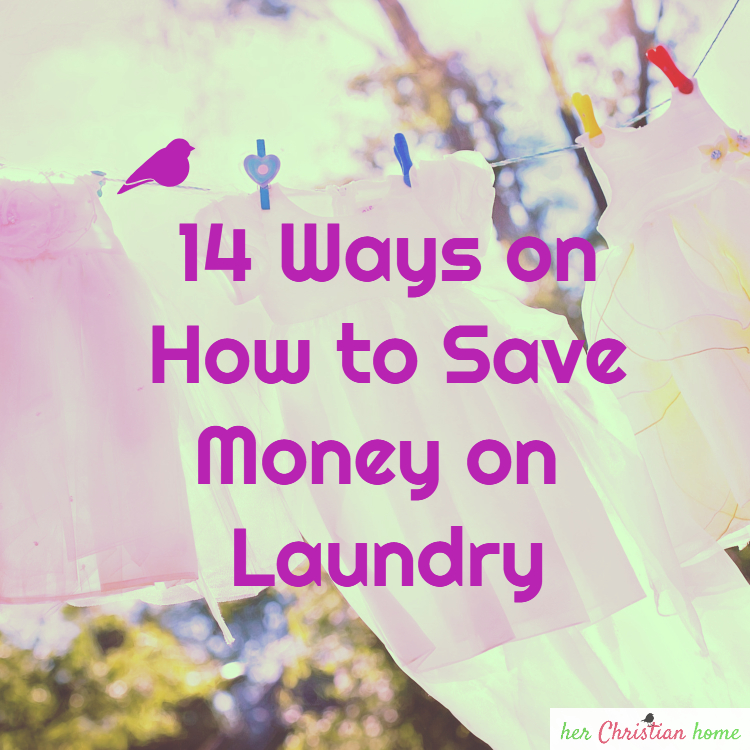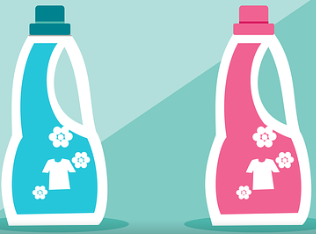 Today, I’m going to share some tips with you on how to save money on laundry, but first let’s discuss the topic of doing laundry…
Today, I’m going to share some tips with you on how to save money on laundry, but first let’s discuss the topic of doing laundry…
Some people love the experience of doing laundry, while others don’t like it so much. Me… I’m sort of in the middle. I’d rather not have to do it, but with the modern-day conveniences of having a washer and dryer doing most of the work, I just can’t complain too much. The hard part is actually folding your clothes and putting them away, right?
The best tip I have with keeping up with your dirty laundry is to have a set day each week to do it. Don’t wait until it’s a mile high because then you’ll get overwhelmed and worn out by the time you get it done. It’s so much easier to take on the work of doing a small load of laundry than a huge one. If you have a larger family, doing a load a day can be helpful.
When your clothes are dry, get them out and put them away as soon as possible. Leaving them in a basket or laying around only adds to the mound of things you have setting around to do — and also allows your clothes to wrinkle the longer they set.
How to save money on laundry
For the average family of four, save over $300 per year!
1. Air-dry your clothes.
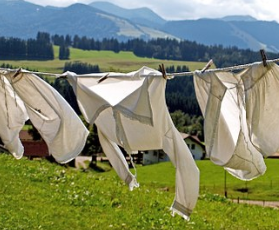
Do you have the space to air-dry your clothes or hang them on the clothes line outside? If you can avoid using a dryer, you can save approximately $100 each year. You will save money on your electric or gas bill, and your clothes will last longer. The heat and tumbling in the dryer damage your clothing.
For many, the spring and summer months will be the easiest time to hang your clothes outside…plus, you save money on running your A.C. to cool your house back down when using a dryer. (Unless you have a dedicated laundry room where no A.C. is used.)
*TIP: If you’re not wanting to “show all” to the neighborhood, use your dryer to dry underwear, and only hang out your heavier pieces like shirts, pants, skirts and towels.
2. Spin your clothes twice.
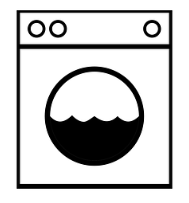
The spin cycle exists to get the excess water out of your clothes. If you spin your clothes twice, you can reduce drying time. You might try this on loads that have heavier materials like jeans and work pants.
3. Use cold water.
While hot water works slightly better, it’s more pricey to heat water which adds to your laundry expense. (*LG Electronics state, “heating the water in the wash drum accounts for about 90% of the energy your machine uses.”) You can save a bundle by choosing to go with cold. You can do cold washes on clothes that need very little cleaning and use hot water on clothes than need extra cleaning power.
*TIP on hot water usage: “You can also set your water heater to at most 120 degrees. Every 10 degree reduction in water heater temperature can save between 3–5 percent in monthly energy costs, according to the U.S. Department of Energy.” *Resource: https://www.sparkenergy.com/en/blog/archive/appliance-electricity-usage-guide/
4. Create your own laundry products.
There are many online “recipes” (check Pinterest) for making your own detergent, bleach, and fabric softeners. These are a fraction of the cost of grocery store laundry soaps.
<< My simple DIY laundry soap recipe: >>
- One box of borax (65 oz)
- One large box of baking soda (64 oz)
- One large box of washing soda (64 oz)
- One box of zote laundry flakes
Mix together well and store in sealed container.
Directions: Use a 1/4 cup scoop per average load. For large loads or extra dirty loads use a double portion.
*You can also add 1/2 cup of white distilled vinegar to your final rinse as a fabric softener.
For those who do NOT want to make their own laundry soap:
-
You can try different generic brands to see which one works the best for your needs.
-
You can also try using soap nuts (*my affiliate link), which a healthier, chemical-free option, and also reduces the cost of laundry detergent compared to some top name brand prices.
5. Use less detergent.
Remember that the companies who make laundry detergent want you to use more than necessary because you’ll have to purchase more.
- Experiment with using less detergent. You’ll probably find you can use half as much.
6. Wash full loads.

The electricity used to fill, agitate, and drain the washer is essentially the same, whether it’s a full or partial load. The same goes for rotating the drum on the dryer.
- Save money by washing and drying more than just one pair of socks; on the other hand, don’t over stuff your washer. Clothes will not be able to circulate efficiently, which means your clothes will not get fully clean.
- Side note: I don’t necessarily adhere to this rule of washing full loads. I keep a minimal wardrobe, so I like to wash my clothes once a week to have them clean and ready to use the following week. I may not necessarily have a full load each time. I also don’t like to spend time separating clothes. So, I usually wash my husband’s clothes on a certain day of the week and mine on another day of the week.
- Hand wash single items rather than doing mini loads if you’re in dire need of a particular clothing piece but it’s not yet laundry day.
7. Consider eliminating white clothing
Something we’ve recently done in the last year is to quit buying whites… and we’ve eliminated most of our whites. (I believe I have one white sweater and one white skirt remaining that I do not wear that often.) This keeps us from washing a separate white load and a dark load. Another bonus is that it saves me the time and effort of keeping white clothes white.
8. Cut those dryer sheets in half.
Half of a dryer sheet is usually sufficient. Experiment to see what works best for you. I just recently purchased Wool Dryer Balls (*my affiliate link) which reduces drying time, wrinkles and static clean, plus they’re cheaper than dryer sheets in the long run.

9. Clean the dryer trap.
Excess lint will trap moisture in the dryer and cause your clothes to take longer to dry. The sooner the dryer shuts off, the less money it costs you. Such a simple tip, but sometimes it gets neglected.
10. Wash your clothes less often.
Some individuals have outdoor jobs or those that require manual labor. But many others have jobs where they can avoid getting dirty or sweating excessively. Items such as t-shirts and underwear will need to be washed after each use. Jeans, dress pants and skirts can often be worn a few times before washing, depending on case by case circumstances. Towels can also be used several times.
- As long as you haven’t soiled your clothing, consider wearing items more than once between washes.
11. Purchase energy efficient appliances.
Washers and dryers differ by brand. There are washers that will handle larger loads and use less water. There are dryers that use much less energy. Sometimes these higher efficiency units cost more, but the savings is worth it in the end. (I have not purchased a newer washer yet because I’m trying to get every bit of last use out of my 17 year old dryer. lol)
12. Adjust your settings.
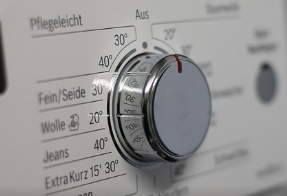
Wash your clothes at a lower setting. Try drying with lower heat. Every load of laundry doesn’t require elaborate settings. Like I said before, try investing in some wool dryer balls (*my affiliate link) to reduce some of the drying time.
13. Unplug your washer and dryer when in not use.
Unplugging your appliances when not being used can help reduce some extra costs. Small amounts of electricity is still be used when your appliances are left plugged into the electrical outlets.
14. Check with your local resources on energy rates.
Some power companies offer discounted rates during non-peak hours. Try to find out when the cheapest time to wash and dry would be in your area. Some say after 8 p.m. that it’s cheaper. (*I called my local electric company, but they denied having any reduced rate time.)
Hey, if you’re adventurous, you can always move to a cheaper state with reduced electricity rates. 🙂 FYI: cheapest 10 states to live in: https://www.chooseenergy.com/electricity-rates-by-state/
Wouldn’t it be nice to have an extra $300 a year to spend on something more entertaining than laundry? Try finding ways to conserve water and electricity and you’ll have more money in your pocket.
Learning how to save money on laundry doesn’t have to happen overnight. One month try making your own laundry soap, then another month perhaps try eliminating whites in your house, etc. The important thing is to make a goal each month of working on reducing costs….little by little you’ll reap the benefits.

